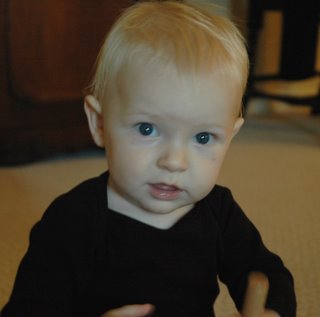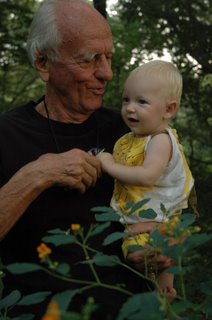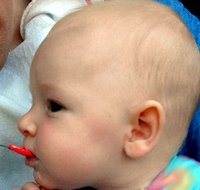 Waterplay On A Mission: Handwashing for Toddlers.
Waterplay On A Mission: Handwashing for Toddlers.As all you Montessori kids know, washing things is a big part of the Montessori life. Practical life includes "Care of Self" which is basically grooming, the central activity of which is handwashing; "Care of the Environment" which, while sometimes ecology-oriented, usually means washing things and tidying up after yourself; and "Grace and Courtesy" which involves the development of other-regarding habits, otherwise known as good manners, only with philosophy attached. Other-regarding-ness comes back around to hygeine and tidiness, and so there you are at handwashing again. See?
Hence we introduce handwashing as an activity (not just a means to an end) early on. Young infants get a quick wipe from an adult before and after meals and after diapering, but the toddler activity is a big step. When first introduced, handwashing is an annoyingly attractive activity, by which I mean that it's hard to get the child to do anything else besides splash in the water and make a sodden mess of everything nearby.
For this reason, I have seen it omitted from many infant communities (Come on, you know who you are!), and underutilized in many primary communities. Just for fun, Montessori parents, sneak a peek at your child's classroom handwashing station. Check it for dust. If you find it's not being used much, it's because while it's a really great practical life activity, many teachers consider it a colossal pain in the ass. It was always a challenge for me to encourage teachers to use it.
To set up toddler handwashing at home, I give the materials list and "simplified" handwashing procedure below.
Parents of older kids: If you have a child in a Primary Montessori class (ages 3-6), I recommend checking with your primary teacher to get her exact handwashing procedure before setting it up at home. Lessons vary in detail from place to place, and the primary handwashing ("involved" handwashing) has a very specific choreography. If your Montessori teacher is using it, she will appreciate your getting it right.
Materials for handwashing: You can order handwashing stations all set up and coordinated from Michael Olaf or other Montessori sites, but I consider this a silly expense for a home setup. I feel a little differently about dishwashing, but we'll get to that.
1. a low table or washstand. I am using my abandoned weaning table (see "Weenie Whiny, Whoa!)
2. a wide, shallow bowl. Mine is enameled, but you could use plastic or ceramic, depending on your tolerance for replacing broken pottery.
3. a small pitcher, manageable by the child, and with a capacity that will give you an inch or two of water in the bottom of your bowl with only one pour. Same considerations about materials as the bowl.
4. a small piece of soap. I like Burt's Bees baby shampoo bar, because it's solid, non-toxic and doesn't sting if it gets in the eyes. You could also use those little flower-shaped guest soaps, or whatever. just make sure the piece is small, so your child can manage it easily. I do not recommend liquid soap for this activity. I'm sure I don't need to explain.
5. a hand towel on a bar, or two baskets and a couple of hand towels. I find the towel bar more convenient for just our family. I have the station set up next to the dishwasher, which has a little towel bar that is at a good height. If you don't have anything readily available, you could install a bar at your child's height, or use the two-basket method. The first basket is for clean towels, the second is for used ones.
6. A little sponge. Probably half of a kitchen sponge will be adequate. A whole sponge is too big, but you will need enough sponge to sop up some water.
7. A bucket with a handle. This is a running theme in Montessori water activities. It is the "slop" bucket. Children learn early in Montessori school that clean water comes from pitchers, and dirty water is carried in buckets. Yes, it is a job to keep a toddler out of the slop bucket. Just empty it every time they use it.
Montessori teachers will carefully color-coordinate all the elements of the handwashing station, and other stations in their classrooms. In addition to eye-pleasing, this is so that it is easy for a child (or teaching assistant) who is tidying up an activity station to see what goes with what. My handwashing station is made up of cute little things I have on hand, and is not particularly matchy.
I admit that for my own toddler (Nuvy is 17 months old), who has just been introduced to handwashing, I keep the station "dry", that is, with the pitcher empty, and I don't have a water source within her reach. She brings me the pitcher if she wants to wash her hands (saying "hands? hands?"), and I fill it for her and supervise the activity closely. Orthodoxy suggests having a water source (like a drink cooler) within the child's reach, but I am just not ready for that kind of insanity yet. Maybe when we get to dishwashing.
You set it up like this:
Starting at the left, place the pitcher, then bowl, then soap, then sponge on the table. Hang the towel above the table, and slightly to the right. Place the bucket on the floor to the right of the table. (If you are using baskets of towels, place them under the table, basket for clean ones on the left, for used ones on the right). This way, the whole activity moves from left to right (an early preparation for reading, I'm told).
Here's the "simplified handwashing" procedure:
Invite the child to wash her hands. Then demonstrate how it is done.
1. Remove the pitcher from the left side of the bowl. Fill it with water.
2. Pour the water into the bowl. Place the pitcher to the right of the bowl. (If there is room on your table, great. If not, I have seen many people just replace the pitcher in its original place. This kind of thing is a typical point of hot debate among the Montessori gurus I know. Personally, I like to move the pitcher to the right. The reason is below.)
3. Dip your hands in the water, deliberately, and only once. Take the soap. Give it three strokes across your hand (count them aloud) and put it back in its place.
4. Rub your hands together to make a lather however you want (Again, Primary handwashing will choreograph the lathering, but for toddlers, we try to respect their limited patience.)
5. Dip your hands in the water again to rinse. Dip them three times. You can count them aloud, or you can flip your hands over for the second dip ("front, back, front").
6. Take them out, fingers pointing down (so that the water drips away from your sleeves). Dry them on the towel. If you are using towel baskets, put the used towel in the right-side basket.
7. Pour the used water into the bucket, then replace the bowl where it was.
8. Use the sponge to wipe off the table, bowl, and pitcher. After you wipe the pitcher, replace it on the left side of the bowl. (So, placing it at the right side is a visual reminder to clean up the handwashing station. Right?). Replace the sponge, and you're done.
The Words: Montessori teachers usually have words to go with each lesson, but I am not giving you any. You know how to talk to your kid. I would only suggest that fewer words are better than more, because they'll stick out better, and the child will learn them easily. Please do use complete sentences, though. For example:
No: "Wet." "Rub." "Dry." "Wipe"
Yes: "I wet my hands." " Here is the soap." "Now I will rinse." "Now I clean up."
No: "Ok, Sweetie, let's wash our hands now. Are you ready? Ok. Now put your hands in the water like this. Goood! Ok, ok, ok. Now here, here, take the soap--- right! No, like this. Now rubrubrubrubrub, and rinse, and rinse and rinse. Great! Now it's time to dry..."
So, I have got to be kidding, right?
No, I am not kidding. Older toddlers can do this pretty easily after a few tries. Little ones, like mine, should not do this activity over, say, hardwood floors, but perhaps over a shower curtain on the floor. Actually, a big towel under the whole thing will help with the watery mess that an 18 month-old will not have the patience to clean up.
If the child takes off in the middle of the activity, it's ok. Just let it go and clean it up, then do it again another time. I really don't suggest that you try this at a time when your child actually NEEDS to wash her hands, for this reason. If you try to keep her there longer than she wants to be there, you kill the joy of the activity. Getting all the way through takes a while.
If the child just wants to pour water between the bucket and the bowl, I would recommend cleaning up the handwashing and putting out another activity for pouring water between two vessels. I have two bowls and a towel in my kitchen for just that purpose. It happens to me every time.
Good luck and have fun!














